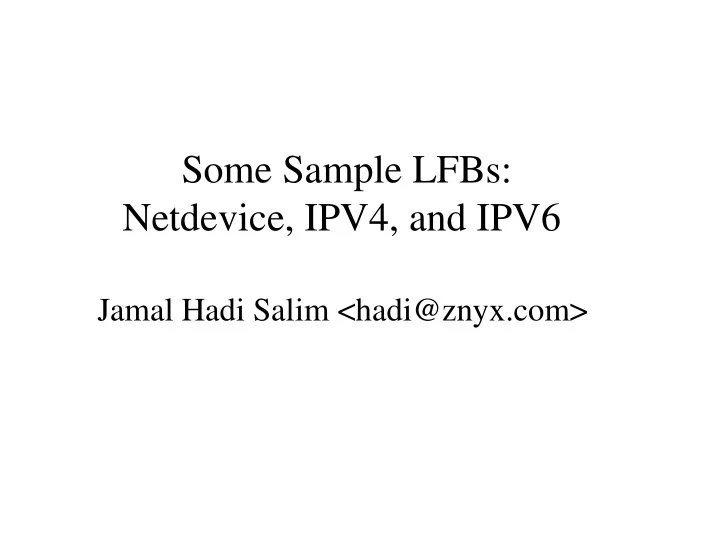

Some Sample LFBs: Netdevice, IPV4, and IPV6 Jamal Hadi Salim <hadi@znyx.com>
Sample LFB topology Local: ICMP, IPV4 FWD UDP TCP etc ARP MPLS IPV6 IPV4 Ingress Egress Netdevice Netdevice Goal to show A simple example topology - then focus on Netdevice and IPV4 LFBs for this presentation - Only 15 minutes allocated (not much time to go into details)
Netdevice LFB ● What has so far been referred to as the Port LFB – Noun Netdevice chosen because port is confusing ● The netdevice LFB abstraction does L1 and L2 processing – This simplifies things and rids of the need for an L1 LFB ● So we can lump things like SPI and XAUI in netdevice – L2 processing includes checking for header validity, etc but not things like L2 forwarding (which is a separate LFB)
Netdevice Model: Capabilities From upstream From upstream LFB LFB Ingress Egress From wire To wire To downstream To downstream LFB LFB ● A Netdevice can have either an ingress and/or egress capability ● A Netdevice can have one or all the input and output ports ● Typical: ingress To-downstream and egress from-upstream ports
Netdevice Model: Capabilities ● A netdevice – Has a type { Ethernet, POS, etc} ● Capabilities adapt on a per type basis – Mention LFBs that can occur before/after ● A netdevice can be connected in a topology to: – any other netdevice for stacking purposes – Any other LFB(L2, L3 etc) determined by configuration – Receives packets from upstream LFBs or the wire – Sends packets to downstream LFBs or the wire – Up/Downstream LFBs could be other netdevices
Other known netdevice types ● Derived from ARP protocol identifiers – Netrom, ax25, pronet token ring, chaosnet, arcnet, appletalk, frame relay DLCI, ATM, metricom STRIP, IEEE1394(firewire), EUI-64, Infiniband, SLIP, CSLIP, SLIP6, CSLIP6, ROSE, AX25, HWX25, PPP, CISCO HDLC, RAW HDLC, Digital's DDCMP, IPIP tunnel, IP6IP6 tunnel, Frame Relay Access Device, SKIP virtual interface, Loopback device, Localtalk, FDDI, AP1000 BIF, SIT tunnel, IP over DDP tunnel, GRE over IP tunnel, PIMSM register interface, HIPPI, Nexus 64Mbps Ash, Acorn Econet, Infrared, Point to point FB, FB arbitrated loop, FB public loop, FB fabric, 802.11 Prism – Some of these maybe aggregated (example “ethernet-like”) ● Capture here to make sure they are not lost ● Need also to look at Interface MIB to see if can use anything
Related LFBs in a topology ● Relationship mapping between netdevice and other LFBs is via topology layout – ARP – IPV4 LPM – IPV6 LPM – QoS/network scheduling – classifier – other netdevices, etc ● Do we need a Mux right after netdevice?
Netdevice Model: Generic attributes ● MIB derived (RFC 2863, 1213, 2233 etc) – ifindex – name – description – stats ● flags – admin, operational, loopback, point-to-point ● device type indicator ● mtu
Netdevice Model:Attributes For Ethernet-like device types addr_len L2Address broadcast_addr mc_count Autonegotiation, promiscuity Flow Control allmutli MAC addr List Optional Link Attribs Link Speed etc
Netdevice Model: Events ● Generally any attribute modifications could result in an event – Admin/Operational ● up/down – Protocol Address ● Adding/Modifying/Deleting – Any other attributes ● Promiscuity, New MAC address etc ● Other Forces-events – Device created, destroyed etc
Example topologies with netdevices IPV4 Over Ethernet IPV4 over PPP Over Ethernet IPV4 IPV4 Ethernet PPP Ethernet IPV4 FWD IPV4 IPV4 SDH Regeneration Bridge Bridge SONET Ethernet Ethernet Ethernet Ethernet PML L2/L3 Switching
Example Setup IPV6 V6 L3 Forwarding V6toV4 tunnel IPV6 IPV4 Bridge Bridge Ethernet Ethernet Ethernet Ethernet Shows: ● more layers/stacks and more netdevice types ● Physical(ethernet), Aggregator(Bridge), Tunnel(SIT) ● Basic protocol translations
model definition ... <LFBClassDefs> <LFBClassDef> <Events> <name>netdevice</name> .. <id>6</id> </Events> <synopsis>Network device LFB</synopsis> .. <version>1.0</version> <attributes> <derivedFrom>baseclass</derivedFrom> <attribute access="read-write"> <name>Netdevtable</name> <capabilities> <id>4</id> <capability> <synopsis>table of netdevices</synopsis> <name>NetdevCount</name> <array type="variable-size"> <id>1</id> <typeRef>netdevdesc</typeRef> <synopsis>Total Number of netdevices</synopsis> </array> <typeRef>uint32</typeRef> </attribute> <name>NetdevCapabTable</name> </attributes> <id>2</id> </LFBClassDef> <synopsis>Table of Capabilities for netedevs</synopsis> </LFBClassDefs> <array type="variable-size"> </LFBLibrary> <typeRef>netdevCapab</typeRef> </array> </capability> </capabilities> Has been implemented (not converted to new schema yet) - implementation tried only for ethernet-like netdevices
IPV4 LFB ● The IPv4 LFB abstraction does L3 IPV4 basic processing – The basic decrement ttl, validate checksum, recompute checksum ● This LFB is not IPV4 Forwarding although it is related ● It owns the multicast/unicast IPV4 addresses in a node – upstream LFBs pass metadata to it to select outgoing IPV4 addresses
IPV4 Model: Capabilities From upstream LFB Error port IPV4 ICMP To downstream LFB ● Implicit tight integration with ICMP ● ICMP is the error and control path ● Not shown is the exception path (eg processing options) ● Really part of the LFB internals
IPV4 Model: Capabilities ● Mention LFBs that can occur before/after ● Can do multicast/unicast
IPV4 attributes v4_local v4_address Address 0 v4_mask Address v4_anycast 1 attributes v4_scope 2 Address table v4_prefixlen . Address name/label Address . rp_filter log_martians mtu etc
IPV6 interface Addres 0 Address 1 Address 2 Attributes table Address . Address .
Recommend
More recommend